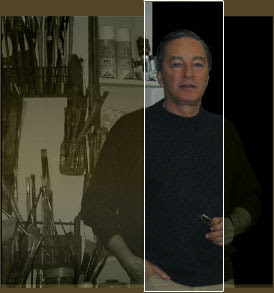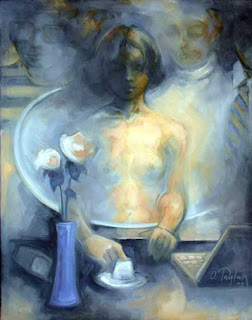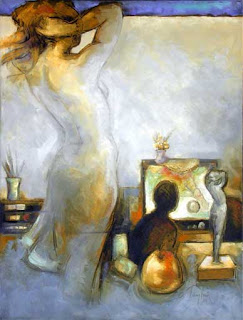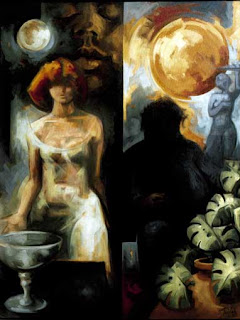
One of the leading proponents of the early 1990s Cynical Realist movement, Fang Lijun’s work encapsulates the disillusionment of China’s youth; a generation defined by the events at Tiananmen Square and China’s internal domestic policies. Constructed around loose narratives Fang’s images personalise sentiments of disenchantment, angst, and rebellion; his fictional suggestions conveyed through his illustrative style and re-occurring bald-headed protagonist.
Fang’s practice exhibits a rarefied technical skill rigorously studied through his Social Realist training; his combination of this aesthetic with references to contemporary comics, folk art, and dynastic painting characterise a national identity in flux, distilling a position of integrity from tradition and the modern world.

Fang’s monumental sized prints revive the ancient Asian practice of woodblock printing -- a complicated and exacting process of carving a ‘negative’ image into a panel, coating the surface in ink, and impressing the image onto paper; each different colour and tone requires a separate plate and order of printing. Due to their immense scale, Fang’s images are composed on several adjoined scrolls; the elongated strips create both an emotive fragmenting of the image, and create a reference to memory and historical testimony. Thematically, each of these prints describe the plight of the individual against the ‘mass’, creating a spiritual contemplation of solitude the quest for personal probity in the face of adversity.
***

China Daily 07/07/2005
BALANCING ACTTan Rui
When Fang Lijun graduated from the print making department of the Central Academy of Fine Arts in 1989, he made an exceptional decision to most people at that time. In a time when the ideal, yet inevitable, outlet for college graduates was to follow the assigned job positions in various work units, Fang, at the age of 26, did not look for any work unit to take him on, but chose to be an independent professional artist living on his own.

In February of the same year, Fang, then still a student, took part in China's first national modern art exhibition in Beijing, during which he displayed, for the first time, his branded paintings of bald headed figures. Ever since, he has been pressing on with a personalized image of bald heads, both in his paintings and his real life. Nowadays, Fang Lijun has become arguably China's most shining "star painter" with successful popularity both at home and abroad.
"It (being called the most shining 'star painter' in China) has nothing to do with me. I am just an ordinary person," Fang said.
Born in 1963 in Handan, Hebei Province, Fang's life became artistic in 1980 when he entered the Hebei Light Industry School to study china and pottery art. In 1985, two years after he graduated from the school, he became a print major at the Central Academy of Fine Arts, where he met a flood of Western thoughts and images which led to a vigorous "new art movement" in the Chinese art circle.
Fang's art became more personal, tracking every step of his thoughts.
"The fantasticality of humanity is absolutely a huge convulsion and enlightenment to me. Humanity has always been the theme of my works, which I interpreted from different angles in different phases," Fang said.
"Currently speaking, my interest is in this aspect. Humans and humanity always remain a mystery to me."
As one of the early active avant-garde artists in China, Fang is widely labelled as the guru of China's "cynic realism," a coined phrase used to describe a small group of artists who take a playful, mocking attitude toward social life and issues. Whether young or old, students or peasants, exciting or bemused, all men in his paintings feature exaggerated expressions and all are bald-headed.
"I find the meaning of the bald head is a great and ambiguous thing. Bald heads are a bit rebellious, but also unclear. For example, monks, soldiers and prisoners are all bald-headed. The appearance of a bald head can eliminate individuality completely, which is totally different from our education. To me, the importance of a bald head is that it annuls the concept of a certain individual to manifest the concept of a person as a whole in a more forceful way. In art history, seldom did any artist bring the common people to the front of the stage," Fang said.
The artist, who has been sporting a shaved head since college, began receiving attention from both home and abroad soon after his art hit the scene. One of his works was even used for the cover of Time magazine in 1993. Fang found himself suddenly in the spotlight of the art circle internationally, and his works became hotly pursued by art establishments and collectors around the world. Despite disputes and comments, Fang proved himself to be a successful artist representing Chinese modern art with a high reputation. As time elapsed, Fang pulled through the phase of excitement and retained his understanding about success, art and life.

"Compared to my original painting intentions, many things have surpassed my original anticipation. The word 'success' does not have too much attraction to me. It is right for one to just live naturally," Fang said.
Like many other artists, Fang dwells in the so-called artists zone Songzhuang Village, where he bought a house and a two-storey studio prominently covered by flourishing Boston ivy. There, he spends his daytime leisurely, either painting, making arrangements, writing something, managing his painting and restaurant businesses or receiving an interview. Lunch is usually enjoyed with his family while dinner is often devoted to accompanying friends outside.
Different from the general conception of what a larruping life and attitude an avant-garde artist should have, Fang is actually quite "market-oriented." Apart from the wide employment of Chinese elements in his paintings to cater to foreign tastes, Fang also opened a stylish restaurant he regards as a media linking him to the real world.
"I work in the studio most of my time. After a long time, I feel terrible and a strong sense of crisis because a painter can become a madman. There isn't a social relation in that state, which means there is no possibility for others to correct you," Fang said. "But running a restaurant, I have to consider the cost and earnings. It provides me with a socialized space which enables me to be a natural person because you cannot take your art career as an excuse and reason to become a mad dog. Of course, the restaurant has many other functions as a place for me to meet my friends, to make money and to have food. It proves one's business ability and poses an important test to see whether you can cooperate with others."
As for the question of how an artists should balance between art and the market, he simply said: "To me, the market is just an additional value like the sound of wind when you run."
http://www.chinadaily.com.cn/english/doc/2005-07/08/content_458313.htm
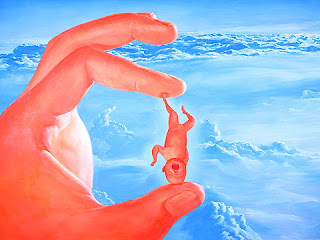.jpg) Cynical Realist Fang Lijun
Cynical Realist Fang Lijunby ben davidson
A fool is someone still trusting after being taken in a hundred times. We'd rather be lost, bored, crisis-ridden misguided punks than be cheated. Don't even consider trying the old methods on us, we'll riddle your dogma with holes, then discard it in a rubbish heap.
I read those strong words in a newspaper article long before I ever saw a Fang Lijun painting. The words are Fang's, as quoted in a 1992 article by China's leading art critic Li Xianting. Li declared Fang the most gifted of the nation's post-89 generation of artists he christened Cynical Realists because of their articulation of the mix of ennui and rogue humor that pervaded Chinese society in the first half of the 1990s. I still had not seen a Fang Lijun painting when a Beijing art groupie told me: Fang Lijun is great. He is the only great artist I have ever met. And he is also a really nice guy. Dozens of art critics, fellow artists and Sino-culture vultures speak of the 36 year-old artist in the same glowing terms. When I did finally see a Fang Lijun painting, I understood what all the fuss was about.
Schooled at a young age in propaganda-style Soviet Socialist Realism, Fang's draughtsmanship is impeccable. He can add a few dabs of white to a canvas of blue oil paint and make you see a swimming pool. Then and this is what makes Fang remarkable he can paint in a bald man, swimming, with an odd facial expression that makes you think I know exactly how that man is feeling, but what the hell is that feeling? If Magritte was a cool Chinese guy, his work may have looked something like Fang Lijun's. Fang's paintings give you a comic book feeling; they hint at stories but a narrative never unfolds. They are peopled by the figure of a shaven-headed man, alone or with a group of clones. This enigmatic skinhead hunches his shoulders slightly, and smiles, sometimes idiotically, sometimes as though he knows something you don't. On a canvas of warm yellows and reds, the skinhead scratches his ear and hugs a plump woman; you feel that you've shared an intimate but comfortable moment with them. In another incarnation in varied hues of gray oil paint, the skinhead sits cross-legged on a beach. His eyes are clenched tight; his face bears the frustrated grimace of straining against constipation. It is uncomfortable to look at but it speaks of a feeling that, if you are human and especially if you live in China, you surely have experienced before. I have an opportunity to meet this enfant terrible of the Chinese art world by tagging along when an old friend of his pays a visit. We drive east out of town on the whimsical sounding Jing Ha Expressway, through the grays and washed-out yellows of the Beijing suburbs to a small village near Tongxian. We turn off onto a small country road cluttered with tacky billboards and sprawling factory complexes. Peasants on bicycles and horse carts carry their implements of labor, children wearing yellow caps cycle home from school in noisy flocks. After getting lost a few times we find the address we are looking for. Pushing open a green sheet-metal gate, we step into a large yard in front of a box-shaped brick warehouse. Two Tibetan Mastiffs who are bigger than me come running for us.

Fang emerges from the warehouse and calls the dogs off. He is wearing Indian-style loose cotton clothes and a navy blue PLA surplus waistcoat. His hair is close-cropped but he doesn't look like a skinhead or a convict. Fang smiles shyly as we shake hands and walk into the studio that he built himself. It is a massive L-shaped brick and blonde-wood building with a loft in the short side of the L. The long side contains a pine desk. On the desk is a slim volume of Chinese history and what the marketing people call a home office: a computer, modem, scanner and fax machine. Behind the desk is a bookshelf holding art books and disorganized looking stacks of papers. Fang takes a fax off the desk and gives it to my friend to translate. It is written in English: an invitation to the 1999 Venice Biennial, a prestigious international art show at which Fang has become a regular feature.
Everything else in the warehouse is completed art or work in progress. A quartet of two-by-four meter canvases lean against a wall. Two of the paintings depict a man swimming, the others consist of groups of people stuck together collage-like against a background of deep blue sky. There is a blink-inducing contrast between the bright colors of these paintings and the brown drabness of peri-urban Beijing in winter, but the difference between Fang's childhood in smalltown Hebei and his current life is no less extreme. Fang's rise to prominence is a Chinese version of the American dream a tale of a young man who leaves his provincial hometown for the promise of a new life in Beijing. He was born to a blue-collar family in the small city of Handan in Southern Hebei. Fang's father was a cadre in the Machinery Division of the Ministry of Railways, but during the Cultural Revolution (1966-1976) he was classified as a rich peasant and demoted to the post of train engineer. The ten years of turmoil were not easy on the Fang family. In a short essay entitled Remembrances Fang recounts his experiences:

A lot of capitalists, landlords, members of the KMT and counter-revolutionaries were dragged out and struggle sessions started to happen all over the place. Being a stupid kid, I went along with the grown-ups shouting out slogans and was happy to go to every denunciation session. One day, when like before I was shouting with the adults for the overthrow of who knows who, my grandfather was forced onto the stage. Around his neck was a placard with the words 'Landlord Fang.'
This happened in 1968. During the next eight years, Fang Lijun was frequently forced to intone Down with Landlord Fang, a slogan that was also pasted by Red Guards on the family house. Fang was persecuted at school by teachers and classmates. His family's house was ransacked by neighbors and Red Guards. The surreal political campaigns of the time did however give the young artist-to-be some opportunities for public expression, although probably not the kind that Dr. Spock would recommend. Fang wrote an essay entitled Dickhead Confucius is a Stupid Pig that was well received in criticism sessions and at school. His cartoons of Lin Biao and Confucius aroused such public mirth that Fang's interest in painting was firmly established, even though his motivation at the time was to further the cause of criticizing an ancient sage and to propagate the thoughts of Chairman Mao.
The Cultural Revolution over, Fang began studying ceramics at the Hebei Light Industry College in 1980. Despite the unpromising-sounding name, this school was where Fang's painting and his ideas about art began to develop. He studied woodcuts. He was introduced to Li Xianting who had just been made the modern art editor of Fine Art (Meishu) magazine. Fine Art intended to publish some of Fang's woodcuts, but the magazine was shut down just after Li's appointment.

After graduation, Fang was assigned to an advertising agency in Handan. He continued to paint, mostly rural scenes depicting huge expanses of bleak land and sky, unpeopled except occasionally for a peasant and mule in the far distance. In 1985, Fang entered the Central Academy of Fine Arts in Beijing. If you have spent more than a few hours in the crowded capital, you will not be surprised to learn that people became a more important feature of Fang's work. His signature motif the man with the shaved head first appeared in 1988. Slumped and defeated looking, skinhead figures began to dominate the once empty landscapes. In some paintings, the figures look like automatons marching in unison; in others they appear to be posing for a family or group photograph.
Fang was still a student in Beijing in 1989. The events of that year crystallized some of his attitudes to art. In Remembrances he describes his feelings at the time: I felt the same suspicions as when I was a kid. I felt doubts about the same things that had troubled me before. I was fascinated by those people who seemed to be just fooling around. To make sense of other people, I concentrated on myself. After all, I was just one of them. But whenever I felt I had made some sort of discovery, everything would just become a blur again. That is when I began my work. Fang painted prolifically during the next few years, producing a body of work recognized both for its formal qualities and for its articulate expression of the zeitgeist. Much of that work was done at Beijing's version of Greenwich Village, the artists' colony that grew up in the area around Yuanmingyuan (the old Summer Palace) between 1990 and 1995. Fang was a leading figure of the Yuanmingyuan Artists' Village, but he left long before 1995 when the police chased all the artists away.

Painting is my life, Fang explains. The Artists' Village became too crowded, it got to be the only way I could work was to sneak in over the back wall and then not answer the door all day. The artists' colony was fine when it started, he continues. But when it got to be well-known and groupies began to make the pilgrimage, the sheer artistic ferment began to decline and it was time to leave. Sure I miss having friends around to drink and eat with when I want to take a break from work, but I do get more work done now.
Soon after Fang moved out to Tongxian (known by some as the East Village to distinguish it from the Old Summer Palace in Beijing's Western suburbs) to pursue a quieter life, he was joined by his former classmate Liu Wei who had also established himself on the international art scene. Since then, many of the artists from the Artists' Village have moved out to Tongxian too, but because they are spread out all over the county, a Tongxian bohemian scene has not developed. Which suits Fang just fine. He is not interested in schools or in labels. When I ask him if he thinks the Cynical Realist tag still makes any sense, he replies with a grin: Well, that's the name everybody knows, but labeling art is not right. Art must be original to be of value, and therefore defies categorization.
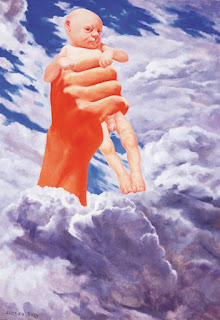
It is difficult to get Fang to talk about his paintings, although he is happy to describe the traditional woodcut techniques he is using on a new series of massive black and white prints that are to be attached to Chinese silk scrolls and exhibited for the first time at this spring's Venice Biennial. I ask him about his plans for the future but he doesn't really answer. I'll paint, play with my dogs, dig in the garden. The angry young man has mellowed, and gone back to the land. I wonder whether Fang's quiet life is a withdrawal from society, the traditional response of the Chinese scholar to the complexities of public life. He interrupts my musings by telling us that he has just returned from Yunnan. I smile: Fang will not be losing touch with the zeitgeist anytime soon. He was not alone in going to Dali and Lijiang this winter, just to hang out. Large numbers of Beijing's hipoisie made the same trek down south, for the same reason. Fang says Yunnan is haowan'r (fun). He smiles wryly as he talks about his holiday. The smile reminds me of an attitude that I see in his paintings, an attitude that might be the only sane way to look at China and the world at the butt end of the twentieth century: easy going cynicism grounded in the acceptance of a flawed reality. I look forward to seeing what Fang's smiling skinhead will make of the early years of the new millennium.




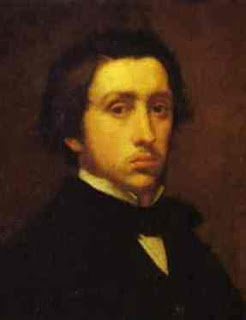





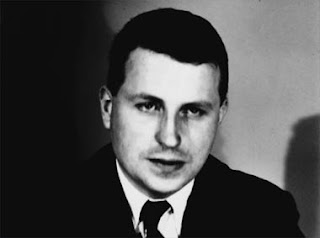
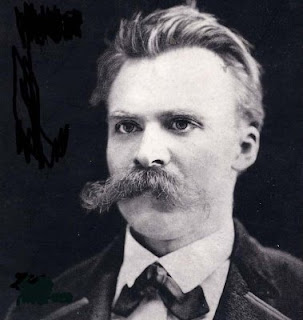

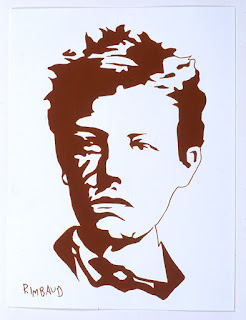


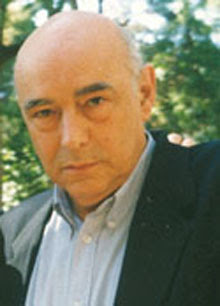
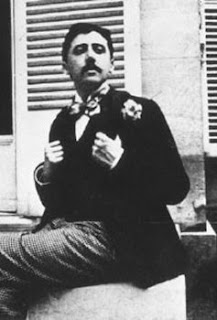
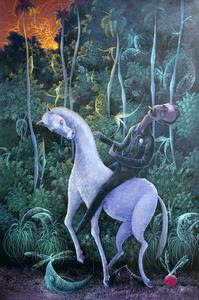


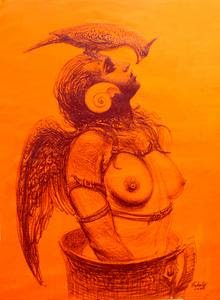












.jpg)








